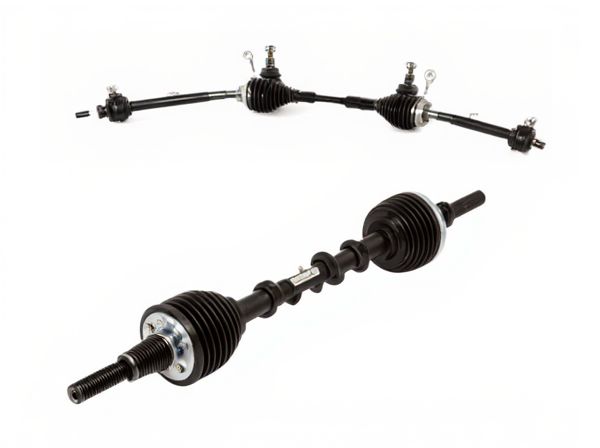
Photo illustration: Solid Shaft Steering vs Collapsible Shaft Steering
Solid shaft steering provides a durable, rigid connection that enhances steering precision and control, making it ideal for heavy-duty or off-road vehicles. Collapsible shaft steering incorporates a safety feature that absorbs impact forces during collisions, reducing injury risk by collapsing upon impact. Choosing between these depends on your priority for safety versus traditional performance in steering response.
Table of Comparison
| Feature | Solid Shaft Steering | Collapsible Shaft Steering |
|---|---|---|
| Safety | Lower impact absorption, higher risk of injury during collisions | Designed to collapse on impact, reducing driver injury |
| Stiffness | High rigidity, provides precise steering feedback | Reduced stiffness due to collapsible mechanisms |
| Weight | Heavier due to solid metal construction | Lighter with integrated energy-absorbing sections |
| Durability | Robust and long-lasting under normal conditions | Durable but may require replacement after activation |
| Cost | Generally lower manufacturing cost | Higher cost due to advanced safety design |
| Applications | Older and commercial vehicles prioritizing durability | Modern passenger cars emphasizing safety standards |
Introduction to Automotive Steering Shafts
Automotive steering shafts are crucial components that connect the steering wheel to the steering mechanism, enabling precise control of a vehicle's direction. Solid shaft steering offers a rigid, durable design commonly used in traditional vehicles for direct feedback and reliability. In contrast, collapsible shaft steering incorporates a safety feature that absorbs impact forces during a collision, reducing driver injury risk through controlled deformation.
Overview of Solid Shaft Steering Systems
Solid shaft steering systems utilize a rigid, continuous metal shaft to connect the steering wheel to the steering mechanism, providing direct and reliable steering control. These systems are known for their durability and simplicity, often found in heavy-duty vehicles and machinery where precise feedback and robustness are critical. The solid shaft design offers minimal flex and high torsional strength, ensuring consistent response even under high stress conditions.
Features and Benefits of Collapsible Shaft Steering
Collapsible shaft steering systems enhance safety by absorbing impact energy during collisions, reducing injury risks compared to solid shaft steering's rigid design. They feature a segmented shaft that telescopes or collapses upon force, protecting the driver and vehicle cabin. This design also improves vehicle compliance with modern safety regulations while maintaining precise steering control and durability.
Safety Considerations: Solid vs Collapsible Shafts
Solid shaft steering systems offer enhanced durability and a more direct steering feel, but they can pose greater injury risks during collisions due to their rigidity. Collapsible shaft steering systems are designed to absorb impact energy by collapsing upon impact, significantly improving occupant safety by reducing the risk of chest and head injuries. Modern vehicles prioritize collapsible shafts to comply with safety regulations and enhance crashworthiness.
Performance Comparison: Solid vs Collapsible Steering
Solid shaft steering offers superior responsiveness and durability due to its rigid construction, making it ideal for high-performance and heavy-duty applications. Collapsible shaft steering excels in safety by absorbing impact forces during collisions, reducing injury risk but may introduce slight play or reduced feedback in steering precision. Performance-wise, solid shafts prioritize control and accuracy, while collapsible shafts balance performance with enhanced safety features.
Cost Implications and Maintenance Needs
Solid shaft steering systems generally have lower initial costs due to simpler design and fewer components, making them a more budget-friendly option for basic vehicles. Collapsible shaft steering, designed with safety collapsibility features, often incurs higher manufacturing and replacement costs but can reduce costly damage repairs during accidents. Maintenance for solid shafts is typically straightforward with periodic lubrication, while collapsible shafts require more frequent inspections and potential component replacements to ensure safety compliance.
Vehicle Compatibility and Applications
Solid shaft steering systems offer robust durability and are commonly used in heavy-duty vehicles such as trucks, buses, and off-road machinery due to their ability to handle high torque and stress. Collapsible shaft steering systems prioritize safety by absorbing impact during collisions, making them ideal for passenger cars and light vehicles where occupant protection is crucial. While solid shafts excel in heavy load applications, collapsible shafts are preferred in vehicles requiring enhanced safety features and compliance with modern crash regulations.
Regulatory and Industry Standards
Solid shaft steering systems comply with traditional regulatory frameworks such as SAE J113 and ISO 3778, ensuring rigidity and durability in vehicle control mechanisms. Collapsible shaft steering meets stringent modern safety standards like FMVSS 203 and ECE R12, designed to reduce driver injury by absorbing impact energy during collisions. Both systems adhere to industry certifications, but collapsible shafts are increasingly mandated for enhanced occupant protection in contemporary vehicle designs.
Recent Innovations in Steering Shaft Technology
Recent innovations in steering shaft technology have enhanced both solid shaft steering and collapsible shaft steering systems by integrating advanced materials such as carbon fiber composites and high-strength aluminum alloys, improving durability and reducing weight. Collapsible shafts now incorporate smart energy-absorbing mechanisms and adaptive damping to better protect occupants during collisions, while solid shafts benefit from precision-machined surfaces and low-friction coatings to optimize steering responsiveness. These technological advancements contribute to increased safety, performance, and fuel efficiency in modern automotive steering systems.
Choosing the Right Steering Shaft for Your Vehicle
Choosing the right steering shaft for your vehicle depends on safety, durability, and driving conditions. Solid shaft steering provides robust strength and reliable feedback, ideal for heavy-duty or off-road vehicles, while collapsible shaft steering enhances crash safety by absorbing impact energy in collisions, making it preferable for passenger cars. Assessing vehicle type, typical road conditions, and safety requirements ensures the selection of an optimal steering shaft that balances performance and protection.
 caratoz.com
caratoz.com